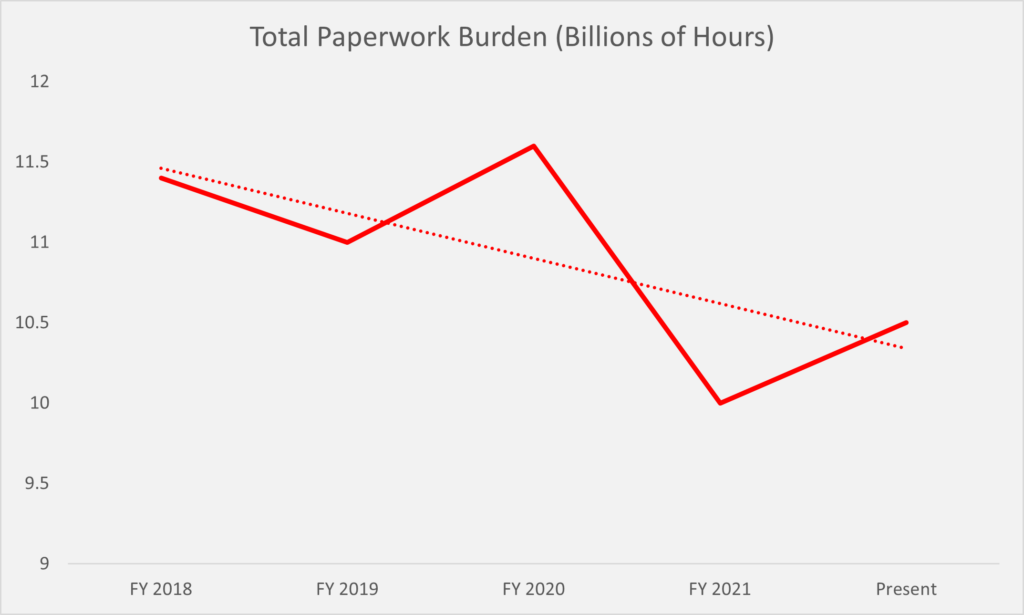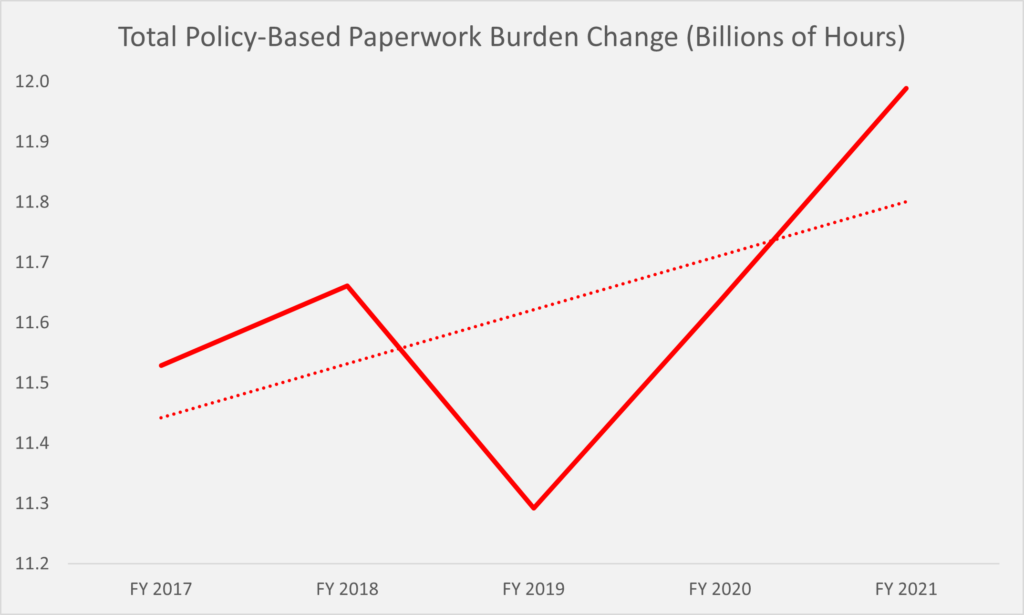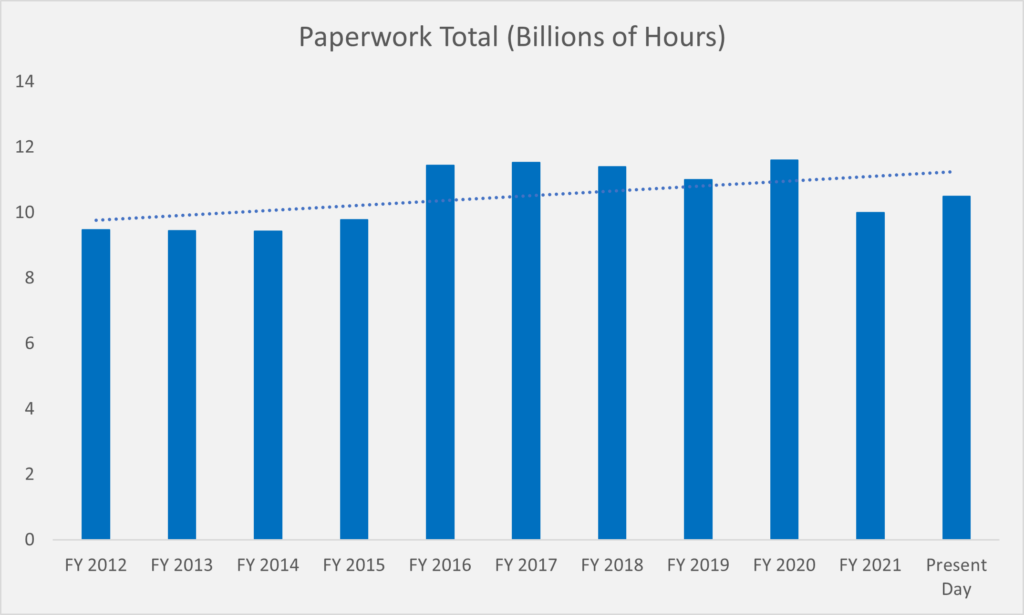Insight
June 1, 2023
Catching Up With the National Paperwork “Budget”
EXECUTIVE SUMMARY
- For the first time in roughly two and a half years, the federal government published its supposedly annual report on government-wide paperwork burdens, which found that such burdens have fluctuated between roughly 10–11.6 billion hours in recent years.
- Although it initially seemed as if there has been a downward trend in paperwork burdens in recent years, a deeper examination of the data reveals that the paperwork requirements attached to actual policy changes have increased the cumulative burden by approximately 460 million hours.
- Such a trend highlights the need for deeper, more structural reforms such as a “paperwork budget” that, even with relatively modest goals in mind, could yield billions of dollars in savings.
INTRODUCTION
For the first time since December 2020, the Office of Management and Budget (OMB) has released its report on the “Information Collection Budget of the United States Government” (ICB). The report is an ostensibly annual exercise under the Paperwork Reduction Act (PRA) that directs OMB “to report to Congress on the paperwork burden imposed on the public by the Federal Government and efforts to reduce this burden.” Given the gap in time since its prior edition, this report covers the data from fiscal years (FY) 2018, 2019, 2020, and 2021. An examination of this data reveals that the PRA continues its now years-long trend of failing to meaningfully constrain – much less reduce – the stock of federal paperwork, thus bolstering the case for additional reforms.
BREAKING DOWN THE TRENDS
The main table (Table 1) from the ICB report gives a summary of the main FY-to-FY trends:
 By way of comparison, here is where the government-wide paperwork total stands today:
By way of comparison, here is where the government-wide paperwork total stands today:
 While there has been some year-to-year variance directionally, the top-line totals would make it seem as though there’s been a nominal downward trend since FY 2018, as illustrated here:
While there has been some year-to-year variance directionally, the top-line totals would make it seem as though there’s been a nominal downward trend since FY 2018, as illustrated here:
 Such a trend is deceptive, however, because it does not account for why the estimated paperwork burden is changing. Returning to Table 1 above, there are four main categories of burden changes:
Such a trend is deceptive, however, because it does not account for why the estimated paperwork burden is changing. Returning to Table 1 above, there are four main categories of burden changes:
1. Discretionary agency actions; 2. New statutory requirements; 3. Lapses in renewal or discontinuation—as a result of the expiration of burden producing activities or lapses in approval of such activities; and 4. Adjustments to existing burden estimates—often as a result of demographic changes, changes in agency estimation methodology, and other outside forces.
The first two categories are the ones that actually account for changes in policy decisions (whether administrative or legislative, respectively). With regard to category one in particular, as OMB notes in this report: “Given that agencies have control over these actions, OMB considers actions within this category of burden change to be the best indicator of agency performance with respect to information collection.” The remaining categories result from either (hopefully unintentional) administrative lapses by agencies or the need to update the data inputs involved based upon external trends.
As one can clearly see from Table 1, the largest downward shift is in the “Adjustments” column for FY 2021. The primary reason for this change, as noted later in this report, was that “the Treasury Department decreased their burden estimates by over 2 billion hours through agency adjustments after reevaluating the burden estimates for business entity tax filers.” That specific action involved Treasury projecting that there would be 200,000 fewer business income tax filers. Such a projection seems like a reasonably intuitive change in assumptions for that time considering how in the second quarter of 2020 – at the peak of the economic disruption wrought by the COVID-19 pandemic – business “establishment deaths” exceeded “establishment births” by nearly 100,000.
When accounting for simply the policy-driven changes in paperwork, however, the trend for the period covered by this ICB report looks more like this:
 From the FY 2017 baseline total of 11.5 billion hours through FY 2021, paperwork burdens that resulted directly from decisions by policymakers increased on net by 460 million hours. The majority of this increase – 399 million hours, to be precise – came from column one, “Discretionary Agency Actions.” This suggests that, over a years-long period, agencies have not felt the need to demonstrate restraint in how they consider the cumulative paperwork situation. Additionally, despite being a part of virtually every prior ICB report, this latest edition did not include a section detailing agency efforts to reduce their paperwork burdens. It is worth noting, however, that this issue does appear to be a significant focus of the “Data Call” for the FY 2022 editon.
From the FY 2017 baseline total of 11.5 billion hours through FY 2021, paperwork burdens that resulted directly from decisions by policymakers increased on net by 460 million hours. The majority of this increase – 399 million hours, to be precise – came from column one, “Discretionary Agency Actions.” This suggests that, over a years-long period, agencies have not felt the need to demonstrate restraint in how they consider the cumulative paperwork situation. Additionally, despite being a part of virtually every prior ICB report, this latest edition did not include a section detailing agency efforts to reduce their paperwork burdens. It is worth noting, however, that this issue does appear to be a significant focus of the “Data Call” for the FY 2022 editon.
WHAT REFORM COULD LOOK LIKE
The trend found in this latest ICB report is hardly out of line with broader historical trends. The following table includes data from the past decade of available ICB reports:
 The year-to-year cumulative paperwork total across this period has ranged from a low of 9.43 billion hours in FY 2014 to a high of 11.6 billion hours in FY 2020 with a consistently upward trendline. Despite multiple executive orders across different administrations, there has been only marginal, short-term downward pressure on paperwork burdens. There simply has not been a framework in place that both: A) takes a properly holistic view of the situation and B) involves consistently measurable constraints on agency actions. What would such a program look like?
The year-to-year cumulative paperwork total across this period has ranged from a low of 9.43 billion hours in FY 2014 to a high of 11.6 billion hours in FY 2020 with a consistently upward trendline. Despite multiple executive orders across different administrations, there has been only marginal, short-term downward pressure on paperwork burdens. There simply has not been a framework in place that both: A) takes a properly holistic view of the situation and B) involves consistently measurable constraints on agency actions. What would such a program look like?
For nearly a decade, the American Action Forum (AAF) has highlighted the conceptual merits of a “paperwork budget.” The core premise of such a program is not dissimilar from the broader “regulatory budget” framework in which agencies and the government writ large set certain policy targets for what the “limit” on new burdens will be and then go about balancing out the burdens involved with new requirements versus savings from eliminating, consolidating, or streamlining old requirements. It is more practical than an overall regulatory budget in that the data are already available in a measurable form, thus avoiding some of the methodological issues with trying to establish “baseline costs” under a regulatory budget. While a paperwork budget would have less of an economic impact than a broader regulatory budget, it would be less politically contentious as it would largely avoid wading into issues of agency regulatory authority
Say, for instance, that under a paperwork budget, there was a mandate to simply restore the government-wide total to the FY 2014 level of 9.43 billion hours. That would represent a roughly 1.09 billion hour decrease from the present day level, or approximately a 10 percent “cut.” Using the average wage rate of a “Compliance Officer,” that represents a potential savings of $40.3 billion. For context, that’s roughly equivalent to the overall net total in new regulatory costs that AAF recorded during the entirety of the Trump Administration. Using the more conservative estimate of the average wage rate across all occupations (to capture simply the opportunity cost of a “typical” worker having to fill out forms) yields roughly $32.4 billion in potential savings. Again, this would merely represent a 10 percent cut back to the level of paperwork present in the middle of President Obama’s second term – a fairly reasonable and modest goal.
CONCLUSION
The “Information Collection Budget of the United States Government” is hardly anyone’s idea of a breezy summer beach read. And considering that it has now had multiple multi-year gaps in its publication schedule with little fanfare (despite technically being an “annual” report), it is likely on the short list of “Most Obscure Government Reports.” Nevertheless, the data and findings included within it have important economic implications. The trends laid out in this and past editions of the report point to the ongoing failure of the Paperwork Reduction Act [emphasis added] in achieving its primary goal and present an opportunity to revisit how the federal government manages its myriad paperwork requirements in a more meaningful and less burdensome way.










